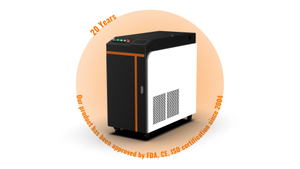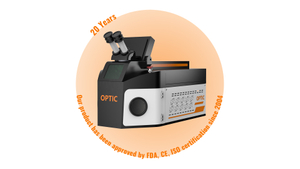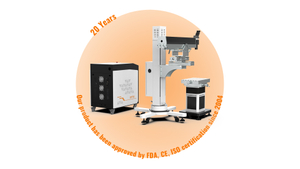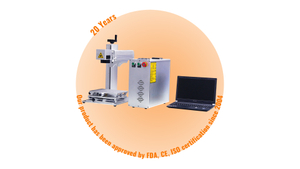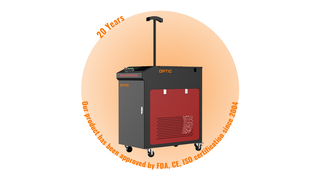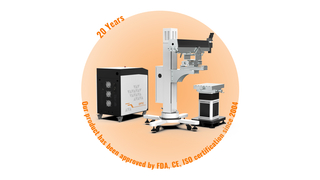Fiber Laser Machine / Resonant Fiber Laser
Fiber Laser machine refers to a laser that uses rare-earth-doped glass fiber as the gain medium. Fiber lasers can be developed on the basis of fiber amplifiers: high power density is easily formed in the fiber under the action of pump light, which causes the laser working material Laser energy level.When properly adding a positive feedback loop (to form a resonant cavity), the laser oscillation output can be formed.
Property:
Broadband fiber optic light source
Key component:
resonant cavity
Principle:
Use rare earth element doped fiber

Introduction
Fiber laser has a wide range of applications, including laser fiber communication, laser space telecommunication, industrial shipbuilding, automobile manufacturing, laser engraving, laser marking, laser cutting, printing rolls, metal and non-metal drilling/cutting/welding (brazing, quenching) Water, cladding and deep welding), military and national defense security, medical equipment, and equipment, large-scale infrastructure, as the pump source of other lasers, etc.
The generation of the laser signal requires three basic conditions: Number of particles Reverse turn, the presence of optical feedback, and the laser threshold. Therefore, the laser is composed of a working substance, a pump source and a resonant cavity. The basic structure of the fiber laser is as follows. The gain fiber is the gain medium that generates photons; the pump light is used as external energy to make the gain medium reach the Number of particles Reverse turn, which is the pump source; the optical resonant cavity is composed of two mirrors , The function is to make the photons get feedback and be amplified in the working medium. The pumped light enters the gain fiber and is absorbed, which in turn makes the energy level in the gain medium Number of particles Reverse turn. When the gain in the resonant cavity is higher than the loss, laser oscillation is formed between the two mirrors, resulting in a laser signal output.
Features of fiber laser
(1) Good beam quality.
The waveguide structure of the fiber determines that the fiber laser is easy to obtain a single transverse mode output, and is not affected by external factors, and can achieve high-brightness laser output.
(2) High efficiency.
Fiber lasers can achieve high light-to-light conversion efficiency by selecting semiconductor lasers with matching emission wavelengths and doped rare-earth element absorption characteristics as pump sources. For ytterbium-doped high-power fiber lasers, 915 nm or 975 nm semiconductor lasers are generally selected, which have a longer fluorescence lifetime and can effectively store energy to achieve high-power operation. The overall electro-optical efficiency of commercial fiber lasers is as high as 25%, which is conducive to cost reduction, energy-saving, and environmental protection.
(3) Good heat dissipation characteristics.
The fiber laser uses a slender rare-earth-doped fiber as the laser gain medium, and its surface area to volume ratio is very large. It is about 1000 times that of a solid bulk laser, which has a natural advantage in heat dissipation. There is no need for special cooling of the optical fiber in low-to-medium power situations, and water-cooled heat dissipation is used in high-power situations, which can also effectively avoid the drop in beam quality and efficiency caused by thermal effects that are common in solid-state lasers.
(4) Compact structure and high reliability.
Since the fiber laser uses a small and flexible fiber as the laser gain medium, it is beneficial to compress the volume and save the cost. The pump source is also a small-sized, easy-to-modularize semiconductor laser. Commercial products generally can be output with pigtails, combined with fiber-based devices such as fiber Bragg gratings. As long as these devices are fused to each other, the full fiber can be realized. High disturbance immunity and high stability, which can save maintenance time and cost.
Existing categories of fiber lasers
Classified according to the type of fiber material
1. Crystal fiber laser. The working material is laser crystal fiber, mainly ruby single-crystal fiber laser, and nd3+: YAG single-crystal fiber laser.
2. Non-linear optical fiber laser. There are mainly stimulated Raman scattering fiber lasers and stimulated Brillouin scattering fiber lasers.
3. Rare-earth doped fiber lasers. The matrix material of the optical fiber is glass, and the optical fiber is doped with rare earth element ions to activate it to make a fiber laser.
4. Plastic fiber laser. Doping laser dye into the core or cladding of the plastic optical fiber to make a fiber laser.
Classified by gain medium:
1. Crystal fiber laser. The working material is laser crystal fiber, mainly ruby single-crystal fiber laser and Nd3+: YAG single-crystal fiber laser.
2. Non-linear optical fiber laser. There are mainly stimulated Raman scattering fiber lasers and stimulated Brillouin scattering fiber lasers.
3. Rare-earth doped fiber lasers. Rare-earth element ions are doped into the fiber to activate it (Nd3+, Er3+, Yb3+, Tm3+, etc., the matrix can be quartz glass, zirconium fluoride glass, single crystal) to make a fiber laser.
4. Plastic fiber laser. Doping laser dye into the core or cladding of the plastic optical fiber to make a fiber laser.
Classified by cavity structure
Divided into F-P cavity, ring cavity, loop reflector fiber resonator, and "8" shape cavity, DBR fiber laser, DFB fiber laser, etc.
Classified by fiber structure
Divided into single-clad fiber laser, double-clad fiber laser, photonic crystal fiber laser, special fiber laser.
Classified by output laser characteristics
Divided into continuous fiber lasers and pulsed fiber lasers, among which pulsed fiber lasers can be divided into Q-switched fiber lasers (pulse width on the order of ns) and mode-locked fiber lasers (pulse width on the order of ps or fs) according to the principle of pulse formation.
As a representative of the third-generation laser technology, fiber lasers have the following advantages
(1) The advantages of miniaturization and intensiveness brought about by the low manufacturing cost of glass optical fiber, mature technology and the flexibility of optical fiber.
(2) The glass fiber does not need to have a strict phase matching for the incident pump light like a crystal. This is because the non-uniform broadening caused by the splitting of the glass matrix results in a wider absorption band.
(3) The glass material has a very low volume-to-area ratio, fast heat dissipation and low loss, so the conversion efficiency is high and the laser threshold is low.
(4) The output laser has many wavelengths: this is because the energy levels of rare earth ions are very rich and there are so many kinds of rare earth ions.
(5) Tunability: Due to the wide energy level of rare earth ions and the wide fluorescence spectrum of glass fiber.
(6) Because there is no optical lens in the resonant cavity of fiber laser, it has the advantages of adjustment-free, maintenance-free and high stability, which is unmatched by traditional lasers.
(7) The optical fiber is exported, so that the laser can be easily qualified for various multi-dimensional and arbitrary space processing applications, making the design of the mechanical system very simple.
(8) Competent in harsh working environment, with high tolerance for dust, shock, impact, humidity and temperature.
(9) No need for thermoelectric cooling and water cooling, just simple air cooling.
(10) High electro-optical efficiency: The comprehensive electro-optical efficiency is as high as 20%, which greatly saves power consumption during work and saves operating costs.
(11) The high-power, commercial fiber laser is six kilowatts.
 English
English


